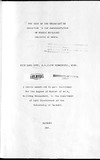| dc.description.abstract | This thesis is a study of the role of the
organization structure in the implementation of public
building construction projects in Kenya. Three case
studies of public organizations have been selected for
examination. The three organizations are the Ministry
of Works, Housing and Physical Planning, the National
Housing Corporation and the Municipal Council of
Mombasa. The study examines the structural design
of these organizations and the problems which arise
when implementing building construction projects.
The study has established that the organization
structures adopted by the three public organizations
are not appropriate or conducive to effective
project management. In most cases, they have tended
to be rigid and bureaucratic. Those dealing with
the projects directly are not given the full authority
to do so and are sometimes overuled by those directly
above them. The interference comes in the form of
instructions which are mostly directives or refusals
of some appropriate decisions taken by those dealing
with the projects.
The first part of this study comprises the
introductory chapter which forms the outline of the study
and introduces the evolution of project organization
structure. Public organizations implementing
building projects in Kenya have been blamed for not
delivering constructed facilities, specifically
building projects, on time, at reasonable cost and
in good form. It is the author's conviction that
the root cause of these problems lies in the way these
organizations are structured and the way institutional
frameworks in the construction industry in Kenya have
come to be adopted and applied without considering
the disadvantages involved. The second chapter,
therefore looks into the concepts associated with
organization structures in order to understand the
problems facing the public organizations charged with
implementing building projects. Chapter three deals
with systems approach and construction organization
structures. Systems theory has had significant impact
on how organizations are viewed. It provides a basis
for understanding the nature of organizations, their
problems and their opportunities.
The second part of this thesis consists of
three case studies. The case study method has been
chosen in an attempt to identify some of the factors
influencing the project implementation process. The
roles of the departments concerned in the implementation
process are examined.- Case studies of the
projects implemented in each of the organizations .~
have been examined with a view of identifying the
organizations effectiveness in managing the projects.
In the projects examined, an attempt has been made
to investigate interdepartmental relationships in the
project implementation process. The project participants
roles were examined to determine how they
integrate to achieve harmony.
The data and information for the case
studies were collected between February and March
1986- through recorded information from project files,
interviews and discussions. The results obtained
from the case studies were found to be similar.
Procedures adopted by the organizations under study
were found to be too lengthy and bureaucratic and
there was lack of integration and conflict of roles
during the implementation process.
Chapter five is the conclusion and
recommendations. | en |

